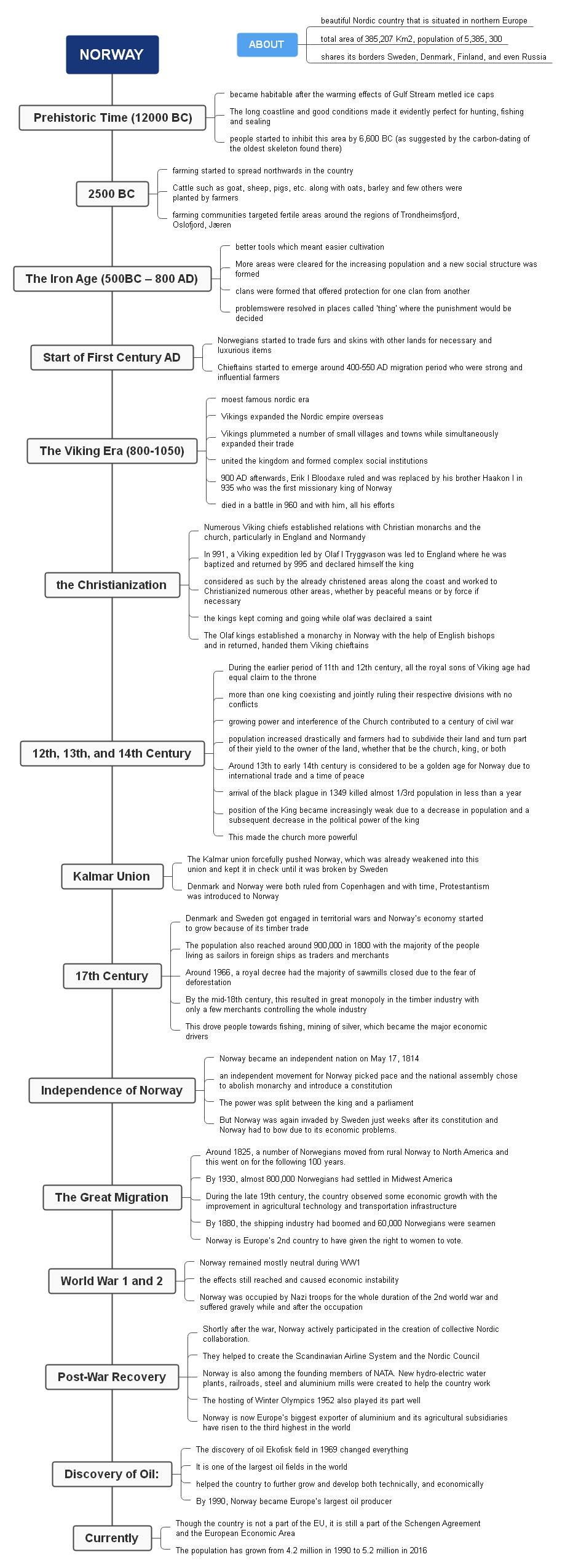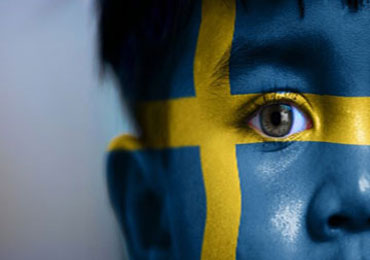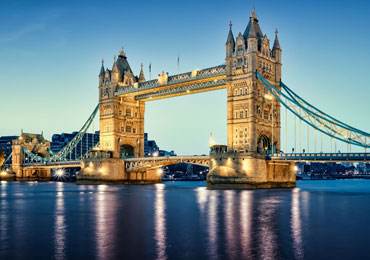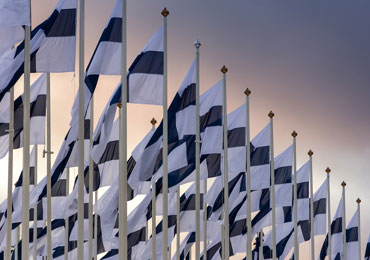The History of Norway
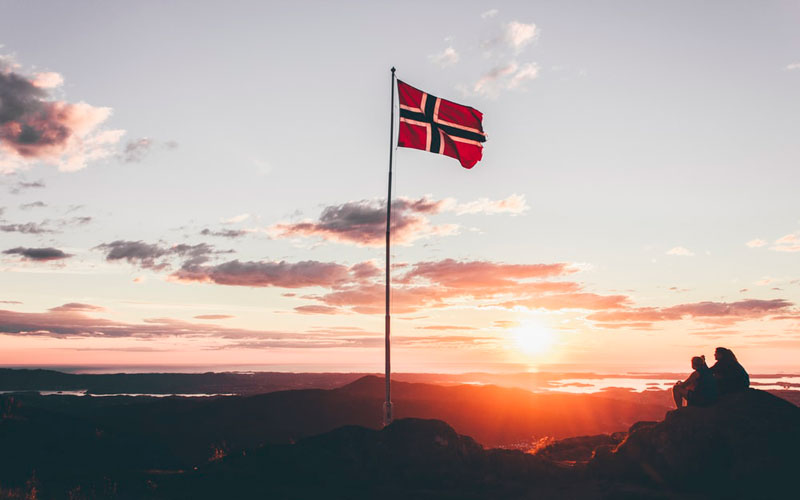
The Kingdom of Norway, or as we call it, Norway is a beautiful Nordic country that is situated in northern Europe. It has a total area of 385,207 Km2 and a population of 5,385,300. It is a beautiful country with a rich history and mesmerizing mountains. The place is a paradise for people who love venturing in the outdoors. It shares its borders with Sweden, Denmark, Finland, and even Russia.
It is house to the world’s longest road tunnel and the most remote island in the world. The Nobel Prize is awarded in Oslo, which is the country’s most densely populated city. The country has given to the world a number of remarkable items such as cheese slicer, skiing, and many others. Let’s have a look at the history of the country from ancient times to the modern.
It was only after the warming effects of the Gulf Stream that the ice that had Norway entirely covered started to melt and gave way for this land to be inhibited. The long coastline and good conditions made it evidently perfect for hunting, fishing, and sealing. Research as late as 1994 has indicated that people started to inhibit this area by 6,600 BC (as suggested by the carbon-dating of the oldest skeleton found there), but ancient literature suggests that it was much earlier.
The people who came here to the region of Oslofjord from farther south used wooden skis and slate tools and started to make a living for themselves.
It was around this time that farming started to spread northwards in the country. Cattle such as goat, sheep, pigs, etc., along with oats, barley, and few others were planted by farmers. Soon they were everywhere. These farming communities targeted fertile areas around the regions of Trondheimsfjord, Oslofjord, Jæren (near Stavanger), Lake Mjøsa (near Lillehammer), and started to make wealth for themselves.
With the beginning of the Iron Age came better tools, which meant easier cultivation. More areas were cleared for the increasing population, and a new social structure was formed. The sons that married were to remain in the same house and extend the family, creating a ‘clan’. This system offered protection for one clan from another. In case conflicts arose, they were resolved in places called ‘thing’ where the punishment would be decided.
The Roman Empire started to expand and exert cultural influence on the surrounding regions. Meanwhile, the Norwegians started to trade furs and skins with other lands for necessary and luxurious items. Chieftains started to emerge around the 400-550 AD migration period, who were strong and influential farmers.
This was the most famous era, not just for Norway, but for all the Nordic Region when Vikings expanded the Nordic empire overseas. The Vikings plummeted a number of small villages and towns while simultaneously expanded their trade. However, they were powerful and highly skilled warriors with all the necessary strategies and equipment needed.
But despite having united the kingdom and forming complex social institutions, Viking chieftains oversaw the arrival of Christianity to Scandinavia. 900 AD afterward, Erik I Bloodaxe ruled and was replaced by his brother Haakon I in 935, who was the first missionary king of Norway. He died in a battle in 960, and with him, all his efforts.
Numerous Viking chiefs established relations with Christian monarchs and the church, particularly in England and Normandy. In 991, a Viking expedition led by Olaf I Tryggvason was led to England, where he was baptized and returned by 995 and declared himself the King. He was considered as such by the already christened areas along the coast and worked to Christianized numerous other areas, whether by peaceful means or by force if necessary.
The charade of one King being replaced by another continued, and Christianity spread all the way to Iceland (990-1000). King Olaf was declared St. Olaf and replaced by his son Magnus. The Olaf kings established a monarchy in Norway with the help of English bishops and in return, handed them Viking chieftains.
During the earlier period of 11th and 12th century, all the royal sons of Viking age had equal claim to the throne, with even more than one King coexisting and jointly ruling their respective divisions with no conflicts. But ultimately, the growing power and interference of the church contributed to a century of civil war.
It was during this time that the population increased drastically, and farmers had to subdivide their land and turn part of their yield to the owner of the land, whether that be the church, King, or both. This accounted for about 20% or more at times. Around 13th to early 14th century is considered to be a golden age for Norway due to international trade and a time of peace. But with the arrival of the black plague in 1349 killed almost 1/3rd population in less than a year.
The position of the King became increasingly weak due to a decrease in population and a subsequent decrease in the political power of the King. This made the church more powerful.
This was around the middle ages, and Sweden was the main benefactor for the christening of Finland. Though the relation between Finland and Sweden date before the arrival of Christianity, it was in the 11th century (according to most archaeologists) that Christianity actually got some footing in the region. The church was still in its development in Finland by the 12th century.
In the 13th century, bishop Thomas became the first bishop of Finland and united all the Finnish tribes under his rule. The conflicts between the Finnish chieftains had weakened them significantly and it was easier for the church to take hold. Sweden was able to take hold of Finland and had it integrated into the medieval European civilization.
The Kalmar union forcefully pushed Norway, which was already weakened into this union, and kept it in check until it was broken by Sweden. Denmark and Norway were both ruled from Copenhagen, and with time, Protestantism was introduced to Norway.
Denmark and Sweden got engaged in territorial wars, and Norway’s economy started to grow because of its timber trade. The population also reached around 900,000 in 1800, with the majority of the people living as sailors in foreign ships as traders and merchants.
Around 1966, a royal decree had the majority of sawmills closed due to the fear of deforestation. By the mid-18th century, this resulted in a great monopoly in the timber industry, with only a few merchants controlling the whole industry. This drove people towards fishing, mining of silver, which became the major economic drivers.
Norway became an independent nation on May 17, 1814, after an independent movement for Norway picked pace and the national assembly chose to abolish the monarchy and introduce a constitution. The power was split between the King and a parliament. But Norway was again invaded by Sweden just weeks after its constitution, and Norway had to bow due to its economic problems.
Around 1825, a number of Norwegians moved from rural Norway to North America, and this went on for the following 100 years. By 1930, almost 800,000 Norwegians had settled in Midwest America. During the late 19th century, the country observed some economic growth with the improvement in agricultural technology and transportation infrastructure. By 1880, the shipping industry had boomed, and 60,000 Norwegians were seamen. Norway is Europe’s 2nd country to have given the right to women to vote.
Although Norway remained mostly neutral during WW1, the effects still reached and caused economic instability. Following this, in the 2nd world war, Norway was occupied by Nazi troops for the whole duration of the war and suffered gravely while and after the occupation.
Shortly after the war, Norway actively participated in the creation of collective Nordic collaboration. They helped to create the Scandinavian Airline System and the Nordic Council. Norway is also among the founding members of NATA. New hydro-electric water plants, railroads, steel, and aluminum mills were created to help the country work. The hosting of Winter Olympics 1952 also played its part well. Norway is now Europe’s biggest exporter of aluminum, and its agricultural subsidiaries have risen to the third highest in the world.
The discovery of the oil Ekofisk field in 1969 changed everything. It is one of the largest oil fields in the world and helped the country to further grow and develop both technically and economically. By 1990, Norway became Europe’s largest oil producer.
Though the country is not a part of the EU, it is still a part of the Schengen Agreement and the European Economic Area. The population had grown from 4.2 million in 1990 to 5.2 million in 2016. The country continues to grow and prosper to date and remains an ideal country in modern times.
